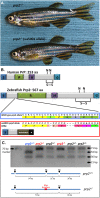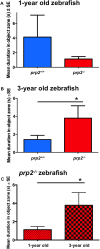An ancient conserved role for prion protein in learning and memory
- PMID: 29358166
- PMCID: PMC5829491
- DOI: 10.1242/bio.025734
An ancient conserved role for prion protein in learning and memory
Abstract
The misfolding of cellular prion protein (PrPC) to form PrP Scrapie (PrPSc) is an exemplar of toxic gain-of-function mechanisms inducing propagated protein misfolding and progressive devastating neurodegeneration. Despite this, PrPC function in the brain is also reduced and subverted during prion disease progression; thus understanding the normal function of PrPC in healthy brains is key. Disrupting PrPC in mice has led to a myriad of controversial functions that sometimes map onto disease symptoms, including a proposed role in memory or learning. Intriguingly, PrPC interaction with amyloid beta (Aβ) oligomers at synapses has also linked its function to Alzheimer's disease and dementia in recent years. We set out to test the involvement of PrPC in memory using a disparate animal model, the zebrafish. Here we document an age-dependent memory decline in prp2-/- zebrafish, pointing to a conserved and ancient role of PrPC in memory. Specifically, we found that aged (3-year-old) prp2-/- fish performed poorly in an object recognition task relative to age-matched prp2+/+ fish or 1-year-old prp2-/- fish. Further, using a novel object approach (NOA) test, we found that aged (3-year-old) prp2-/- fish approached the novel object more than either age-matched prp2+/+ fish or 1-year-old prp2-/- fish, but did not have decreased anxiety when we tested them in a novel tank diving test. Taken together, the results of the NOA and novel tank diving tests suggest an altered cognitive appraisal of the novel object in the 3-year-old prp2-/- fish. The learning paradigm established here enables a path forward to study PrPC interactions of relevance to Alzheimer's disease and prion diseases, and to screen for candidate therapeutics for these diseases. The findings underpin a need to consider the relative contributions of loss- versus gain-of-function of PrPC during Alzheimer's and prion diseases, and have implications upon the prospects of several promising therapeutic strategies.
Keywords: Alzheimer; Anxiety; Learning; Novel object recognition; Targeted Mutagenesis; Zebrafish.
© 2018. Published by The Company of Biologists Ltd.
Conflict of interest statement
Competing interestsThe authors declare no competing or financial interests.
Figures





Similar articles
-
Prion gene paralogs are dispensable for early zebrafish development and have nonadditive roles in seizure susceptibility.J Biol Chem. 2018 Aug 10;293(32):12576-12592. doi: 10.1074/jbc.RA117.001171. Epub 2018 Jun 14. J Biol Chem. 2018. PMID: 29903907 Free PMC article.
-
Targeted mutation of the gene encoding prion protein in zebrafish reveals a conserved role in neuron excitability.Neurobiol Dis. 2013 Jul;55:11-25. doi: 10.1016/j.nbd.2013.03.007. Epub 2013 Mar 21. Neurobiol Dis. 2013. PMID: 23523635
-
High molecular mass assemblies of amyloid-β oligomers bind prion protein in patients with Alzheimer's disease.Brain. 2014 Mar;137(Pt 3):873-86. doi: 10.1093/brain/awt375. Epub 2014 Feb 10. Brain. 2014. PMID: 24519981
-
Pathogenic mechanisms of prion protein, amyloid-β and α-synuclein misfolding: the prion concept and neurotoxicity of protein oligomers.J Neurochem. 2016 Oct;139(2):162-180. doi: 10.1111/jnc.13772. Epub 2016 Sep 15. J Neurochem. 2016. PMID: 27529376 Review.
-
PrP(C) signalling in neurons: from basics to clinical challenges.Biochimie. 2014 Sep;104:2-11. doi: 10.1016/j.biochi.2014.06.009. Epub 2014 Jun 18. Biochimie. 2014. PMID: 24952348 Review.
Cited by
-
Vision of conspecifics decreases the effectiveness of ethanol on zebrafish behaviour.PeerJ. 2021 Jan 15;9:e10566. doi: 10.7717/peerj.10566. eCollection 2021. PeerJ. 2021. PMID: 33520441 Free PMC article.
-
Comparing Prion Proteins Across Species: Is Zebrafish a Useful Model?Mol Neurobiol. 2025 Jan;62(1):832-845. doi: 10.1007/s12035-024-04324-z. Epub 2024 Jun 25. Mol Neurobiol. 2025. PMID: 38918277 Free PMC article. Review.
-
Show Me Your Friends and I Tell You Who You Are: The Many Facets of Prion Protein in Stroke.Cells. 2020 Jul 2;9(7):1609. doi: 10.3390/cells9071609. Cells. 2020. PMID: 32630841 Free PMC article. Review.
-
Cellular Prion Protein (PrPc): Putative Interacting Partners and Consequences of the Interaction.Int J Mol Sci. 2020 Sep 25;21(19):7058. doi: 10.3390/ijms21197058. Int J Mol Sci. 2020. PMID: 32992764 Free PMC article. Review.
-
Reduced Abundance and Subverted Functions of Proteins in Prion-Like Diseases: Gained Functions Fascinate but Lost Functions Affect Aetiology.Int J Mol Sci. 2017 Oct 24;18(10):2223. doi: 10.3390/ijms18102223. Int J Mol Sci. 2017. PMID: 29064456 Free PMC article. Review.
References
-
- Ahmed T. S., Fernandes Y. and Gerlai R. (2012). Effects of animated images of sympatric predators and abstract shapes on fear responses in zebrafish. Behaviour 149, 1125-1153. 10.1163/1568539X-00003011 - DOI
LinkOut - more resources
Full Text Sources
Other Literature Sources
Molecular Biology Databases
Research Materials

